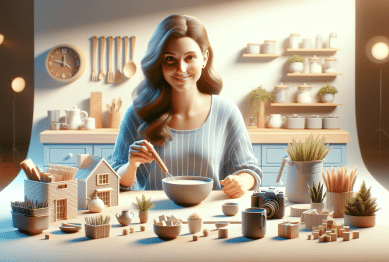Discover how to design a cozy minimalist home that blends modern style with inviting comfort. Learn about practical decluttering techniques, storage ideas, and mindful decorating for a harmonious living environment that easily adapts to your daily lifestyle.
Understanding the Cozy Minimalist Trend
Minimalism has long captured attention for its simple aesthetic and stress-reducing appeal. Cozy minimalism, a newer lifestyle trend, goes a step further by creating an inviting atmosphere within uncluttered spaces. This approach promotes comfort without sacrificing style, making it an increasingly popular option for those who value both tranquility and function in daily living. Instead of stark rooms, the cozy minimalist home uses warm textures, soft lighting, and carefully chosen décor to strike balance. People are drawn to this style because it offers a practical way to streamline possessions while nurturing a sense of calm and connection in the home. Key factors driving this trend include increased time spent at home, the desire for simplicity, and growing awareness of mental wellness benefits linked to tidy, purposeful surroundings.
Unlike traditional minimalism, which can sometimes feel cold or impersonal, the cozy minimalist style invites residents and guests to relax. Soft throws, cushy seating, and a focus on natural materials help create a comforting ambiance. The approach is not about stripping everything away but rather curating pieces that bring joy and functionality. For many, this means integrating meaningful art, displaying favorite books, or keeping cherished blankets at hand—all without overcrowding the space. The intention is to make every item purposeful, supporting both aesthetics and daily routines. As more people pursue wellness at home, the cozy minimalist model provides guidance for creating spaces that inspire peace without feeling empty.
Ultimately, the cozy minimalist home centers on mindful consumption and intentional design choices. Spaces are arranged to promote easy movement and clear thinking. This sometimes means letting go of items that no longer serve, as well as resisting the urge to fill every available corner. Instead, emphasis is placed on open layouts, calming colors, and a select number of comforting accents. Homeowners find freedom in owning less, gaining a home that feels both organized and nurturing. For those interested in modern lifestyle trends, cozy minimalism is a compelling blueprint for transforming any living area into a soothing retreat.
Decluttering Your Space With Purpose
The first step toward a cozy minimalist lifestyle is thoughtful decluttering. This involves more than simply cleaning up; it’s about evaluating which items add value and which contribute to visual or emotional clutter. Many find it empowering to sort possessions by category—such as kitchen gadgets, books, or clothing—and then make decisions based on use and attachment. This method not only clears out unwanted items but also highlights pieces that truly matter. The result is a room—and ultimately a home—that feels lighter, more manageable, and more aligned with your personal style. Even just a few hours spent decluttering can produce a noticeable improvement in how a space feels and functions.
Experts recommend starting with small projects to avoid overwhelm. For example, organizing a single drawer or shelf can offer motivation to tackle bigger challenges later. Some people use the principle of one-in, one-out to keep clutter at bay. This means for every new item brought in, an existing item leaves. Regular reviews, even monthly or quarterly, help reinforce intentionality and curb the slow accumulation of extra belongings. Decluttering with purpose also reveals what storage solutions might work best. Open shelving, hidden compartments, and stackable bins can all contribute to a tidy environment that is easy to maintain.
Importantly, decluttering supports not just aesthetics but also mental wellbeing. Studies show that clutter can lead to higher stress levels and lower productivity, while organized spaces improve mood and reduce anxiety (https://www.ncbi.nlm.nih.gov/pmc/articles/PMC5579396/). Many individuals find that reducing possessions frees up mental space, making it easier to relax, focus, and enjoy time at home. Whether beginning with a closet purge or a full-room overhaul, the process is an investment in long-term peace of mind.
Incorporating Warmth With Intentional Decor
It’s a common misunderstanding that minimalist spaces must lack personality or comfort. In the cozy minimalist home, intentional decorating choices bring warmth and character. Natural textures, such as woven baskets, wool throws, and wood accents, create tactile interest without creating clutter. Neutral color palettes of beige, cream, or soft gray promote tranquility, while strategically placed plants add life and a burst of color. Each decorative element is chosen for its meaning and its ability to improve mood. Layering soft fabrics and adding a few beloved art pieces further contribute to the inviting atmosphere. When arranging these details, keeping open space between items is key, as it allows each piece to shine without overwhelming the senses.
Lighting plays a crucial role in setting the right tone. Rather than relying solely on harsh overhead lights, cozy minimalist homes use floor lamps, table lamps, or even string lights to create pools of gentle illumination. Candles, whether real or battery-operated, add another softening layer, enhancing the sense of relaxation and warmth. These light sources can be moved or adjusted throughout the day to match shifts in mood or activity. The result is a flexible environment that adapts to the rhythms of daily life, encouraging restful evenings and energized mornings alike.
Selecting wall art and accessories in line with the cozy minimalist ethos means editing rather than accumulating. A single large print, a grouping of family photos, or a curated gallery wall can become focal points without creating unnecessary visual busy-ness. The goal is to display pieces that are truly loved, not just filling space for the sake of aesthetics. This fosters satisfaction and pride in the home environment, reinforcing the connection between surroundings and well-being. Minimalist doesn’t mean empty—it means every element matters.
Maximizing Storage Without Sacrificing Style
Smart storage strategies are vital for maintaining a cozy minimalist home. Open shelving allows for the display of useful or visually pleasing items, while closed cabinets hide less attractive essentials. Multi-functional furniture is also popular—think ottomans bursting with extra blankets or benches with under-seat storage. These pieces help keep clutter at bay without making the room look sterile. In bedrooms and living areas, taller storage units draw the eye upward and create the illusion of greater space. Under-bed boxes are perfect for stashing off-season clothing, keeping everything organized yet out of sight. By integrating storage into the design, it becomes possible to enjoy both minimalism and everyday convenience.
Staying organized means regularly reviewing what is stored to ensure it remains relevant. Items that go unused for extended periods are candidates for removal or donation. Labeling bins and baskets promotes easy access and makes putting things away almost effortless, especially for families or roommates. Digital tools, like inventory apps, can help keep track of possessions for those who want an extra layer of organization. Even small spaces—studio apartments or shared living quarters—can benefit from wall-mounted hooks, foldable furniture, or modular shelving systems. The key is choosing solutions that blend seamlessly with decor, supporting both style and structure.
It’s important to remember that storage isn’t just about hiding things away. In cozy minimalism, displaying select items—favorite books, records, or sentimental mementos—can add personality without clutter. Rotating these displays keeps them feeling fresh and prevents overload. Thoughtful storage encourages ongoing tidiness, supports mindful shopping habits, and helps transform organization into an enjoyable routine rather than a chore. As a result, the home feels welcoming day after day, ready for moments of relaxation or celebration.
Mindful Habits for Sustaining a Minimalist Lifestyle
Achieving a cozy minimalist home is just the beginning; maintaining it requires ongoing attention and intention. Mindful shopping is essential—before making new purchases, it helps to ask whether an item serves a need, fits within the aesthetic, and adds real value. Keeping a running ‘maybe’ list can reduce impulse buys, making purchases more conscious and calculated. This approach not only saves money but reduces waste, supporting sustainability in everyday life. Minimalist experts suggest considering the emotional significance of items, prioritizing those that spark joy or boost functionality.
Daily habits also play a critical role in sustaining an organized home. Quick morning tidying, regular donation drops, and having set places for essential items keep clutter from returning. Introducing rituals like resetting surfaces each evening can make cleanup feel like a calming practice rather than a dreaded task. For families or shared households, creating clear storage zones and open spaces encourages everyone to contribute, helping the entire household enjoy the benefits of minimalist living. These habits foster a positive home environment, supporting everything from deeper sleep to more enjoyable gatherings.
Mindful living extends beyond possessions; it encompasses how we use our spaces and the intentions we set for our time at home. Regularly enjoying cozy reading nooks, meditating in peaceful corners, or hosting quiet dinners with friends helps reinforce the value of a well-kept, minimalist home. Over time, these routines build a lifestyle where comfort coexists with simplicity. This offers lasting satisfaction and turns a cozy minimalist home from a trend into a way of life.
Adapting Minimalism for Different Lifestyles
Cozy minimalism is adaptable, allowing for customization based on personal and familial needs. Single professionals, busy parents, and retirees alike can tailor the approach to suit their unique rhythms and priorities. For families, designating a basket for daily toys or schoolwork maintains order while keeping children engaged. Singles might prioritize serene reading areas or streamlined work-from-home setups that transition easily from day to night. Sharing spaces doesn’t mean compromising on style; collaborating on design choices can actually foster stronger connections and shared responsibility.
For renters or those in smaller homes, flexibility is especially important. Wall-mounted shelves, portable storage units, and foldable furniture let individuals adapt spaces without investing in permanent changes. This makes it possible to enjoy cozy minimalism even in temporary living situations, with little risk or expense. In larger homes, spreading minimalist principles across multiple rooms—rather than concentrating them in just one area—promotes a cohesive, relaxing atmosphere. Each room can serve a unique function while maintaining an overarching sense of harmony and simplicity.
For many, the biggest reward of cozy minimalism is the freedom it provides. Less time spent cleaning, organizing, and searching for lost items means more time for hobbies, family, and relaxation. With mindful planning and consistent routines, everyone can experience a home that supports well-being and personal growth. Inspired by friendly decorating forums and real-life stories, adapting cozy minimalism can become a fulfilling journey for anyone seeking a softer, more intentional lifestyle.
References
1. Saxbe, D. E., & Repetti, R. L. (2010). No place like home: Home tours correlate with daily patterns of mood and cortisol. Personality and Social Psychology Bulletin, 36(1), 71-81. Retrieved from https://journals.sagepub.com/doi/10.1177/0146167209352864
2. National Institutes of Health. (2017). Clutter, Chaos, and Overstimulation: The Impact on Stress and Cognitive Health. Retrieved from https://www.ncbi.nlm.nih.gov/pmc/articles/PMC5579396/
3. American Psychological Association. (2021). How clutter affects your brain—and what you can do about it. Retrieved from https://www.apa.org/news/apa/2021/clutter-brain
4. The Spruce. (n.d.). How to Create a Cozy-Minimalist Home. Retrieved from https://www.thespruce.com/create-cozy-minimalist-home-5072320
5. Wellness Institute, Cleveland Clinic. (n.d.). Minimalism for Mental Health. Retrieved from https://my.clevelandclinic.org/health/articles/23130-minimalism-for-mental-health
6. University of Minnesota. (n.d.). The power of cleanliness: physical environment and mental wellness. Retrieved from https://www.takingcharge.csh.umn.edu/power-cleanliness









